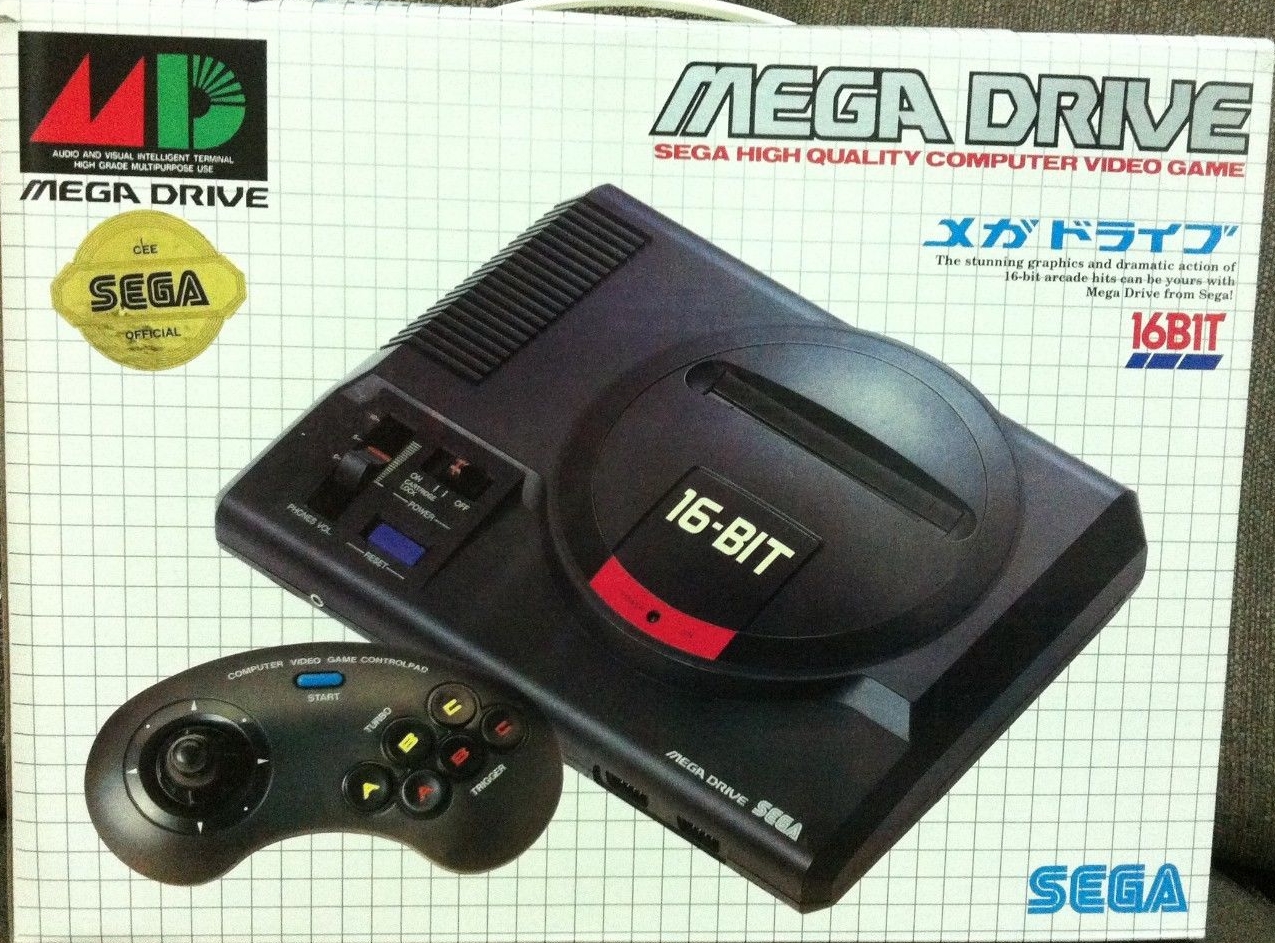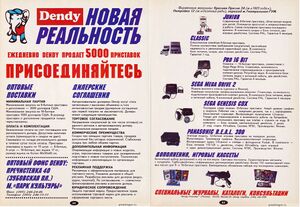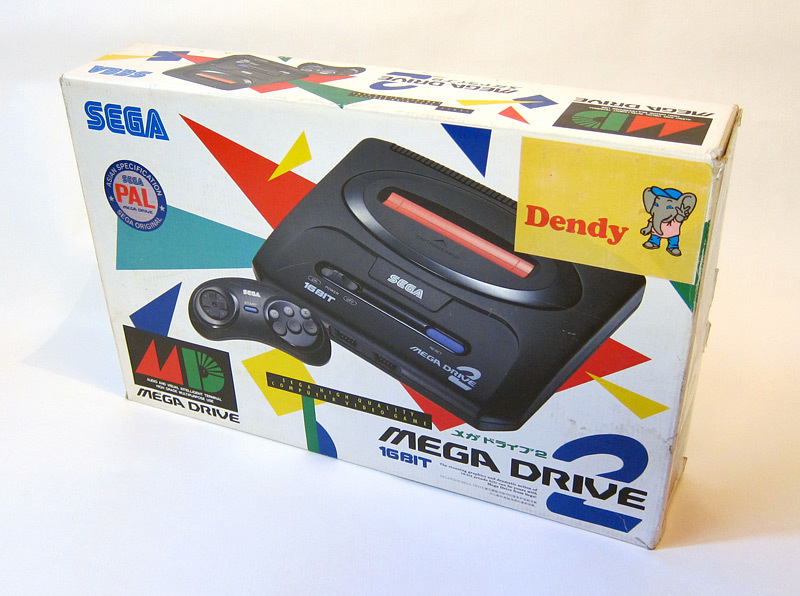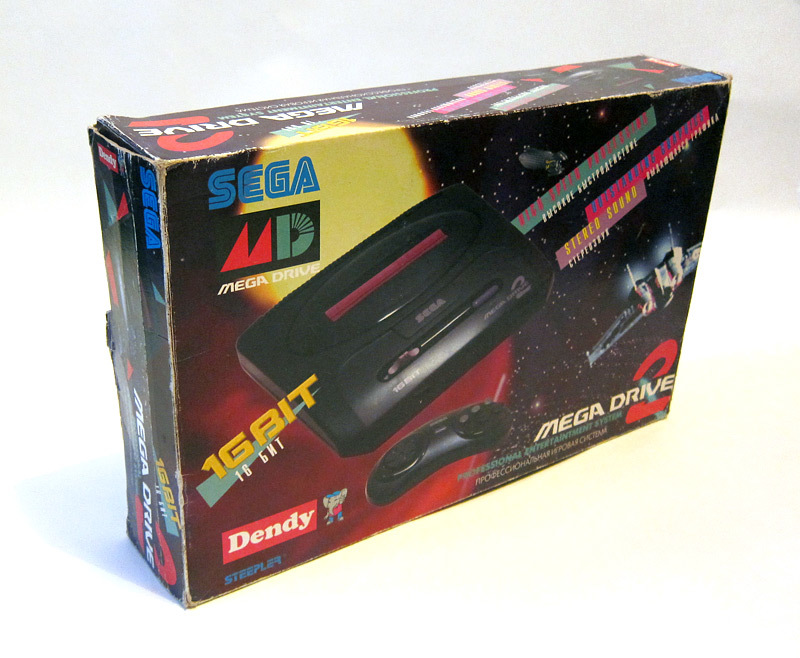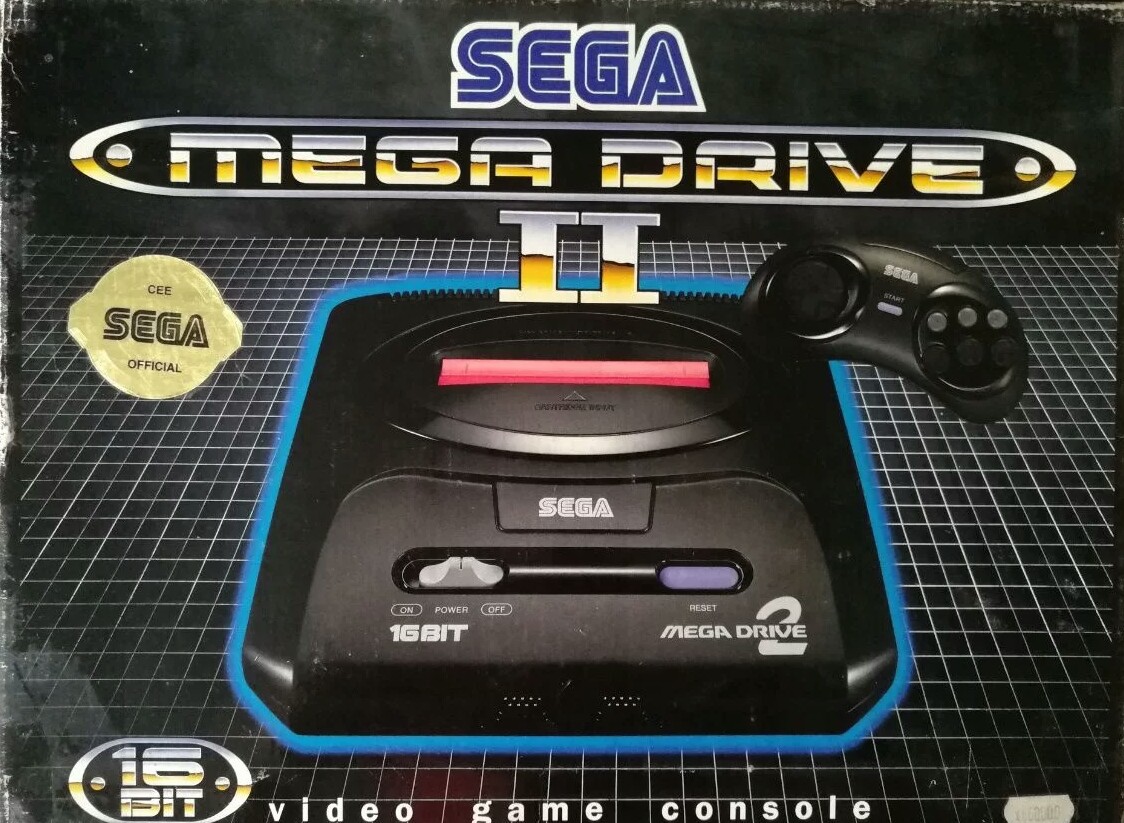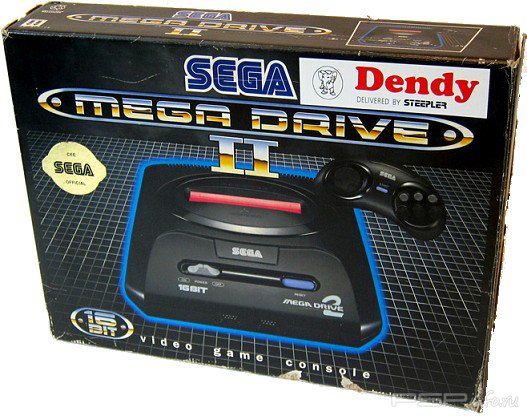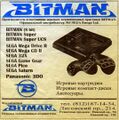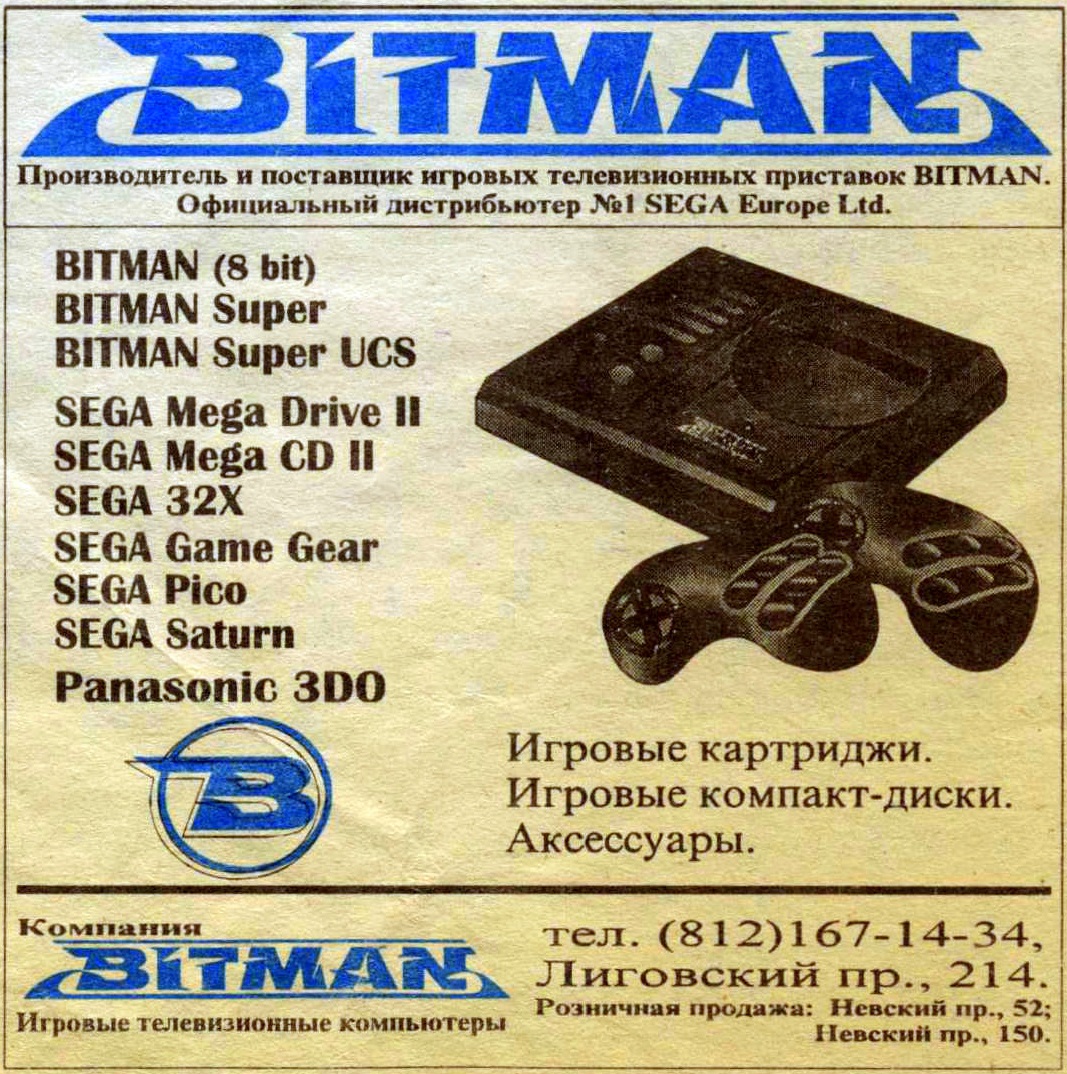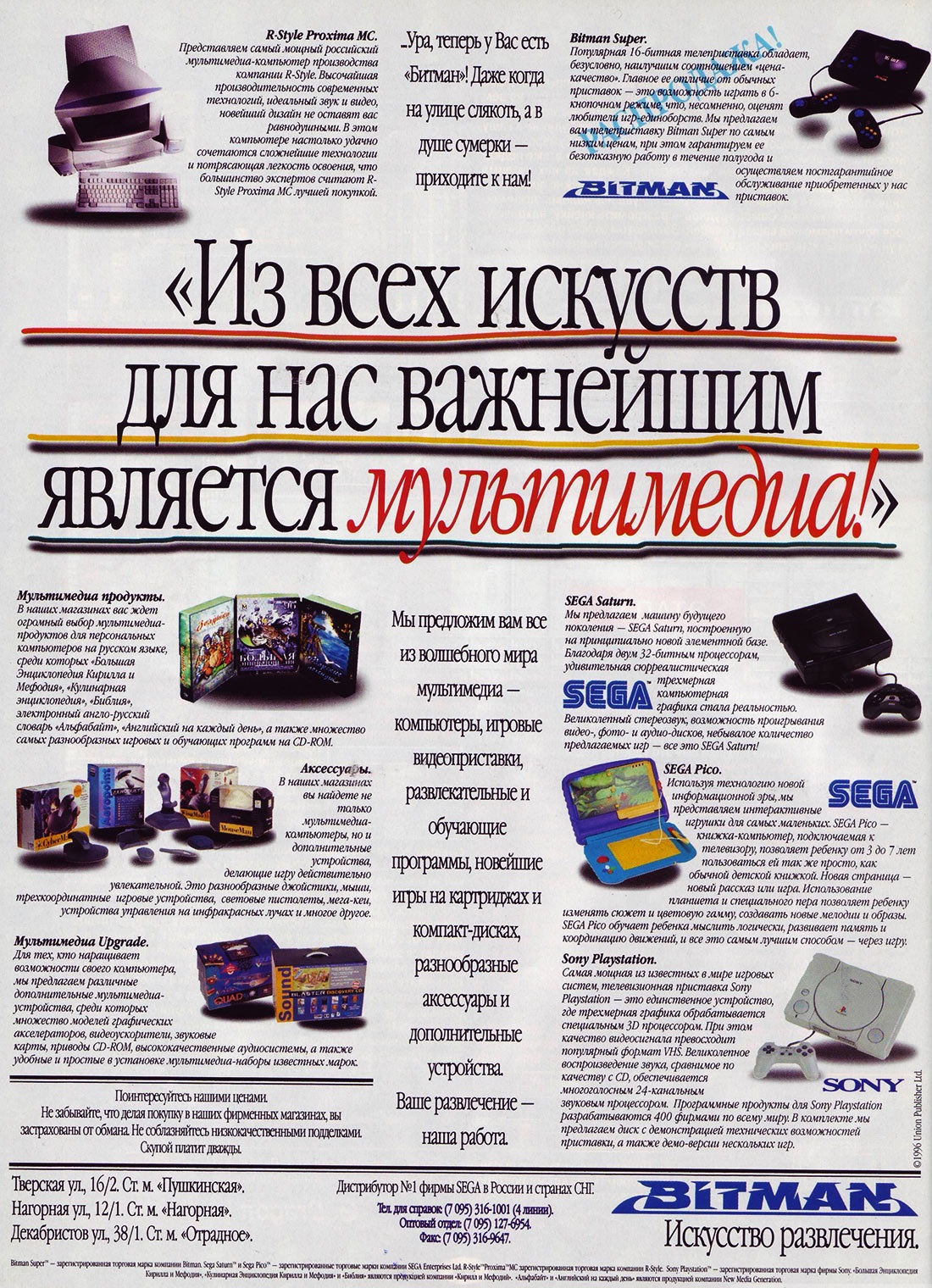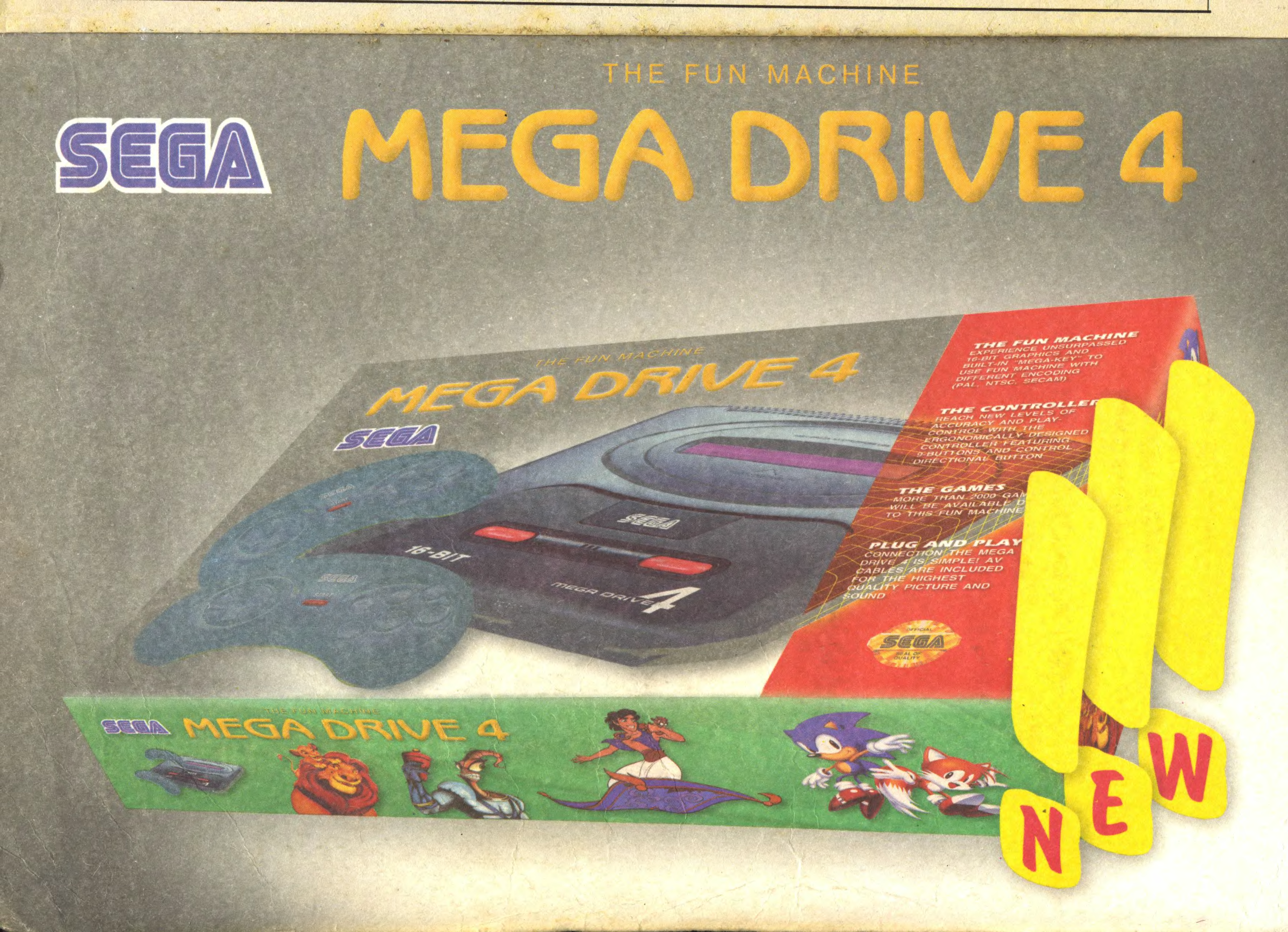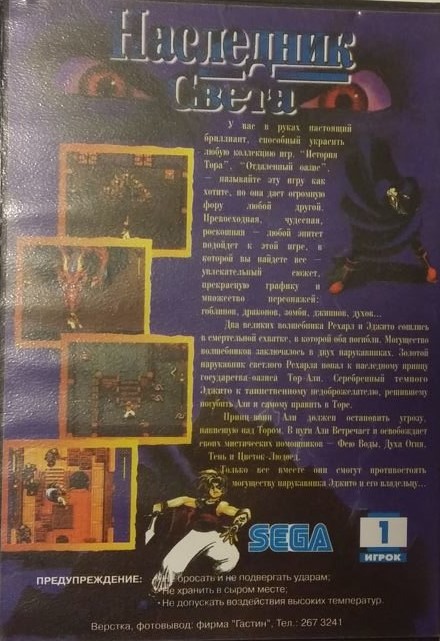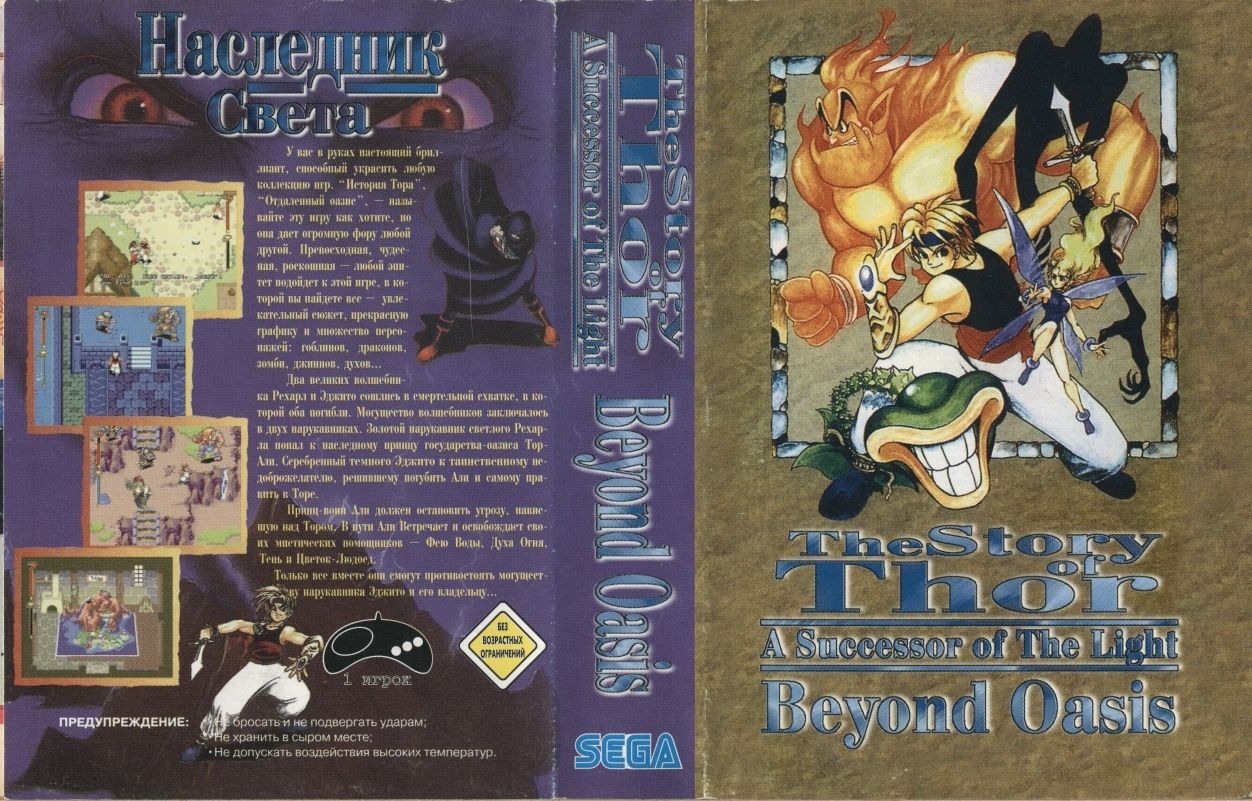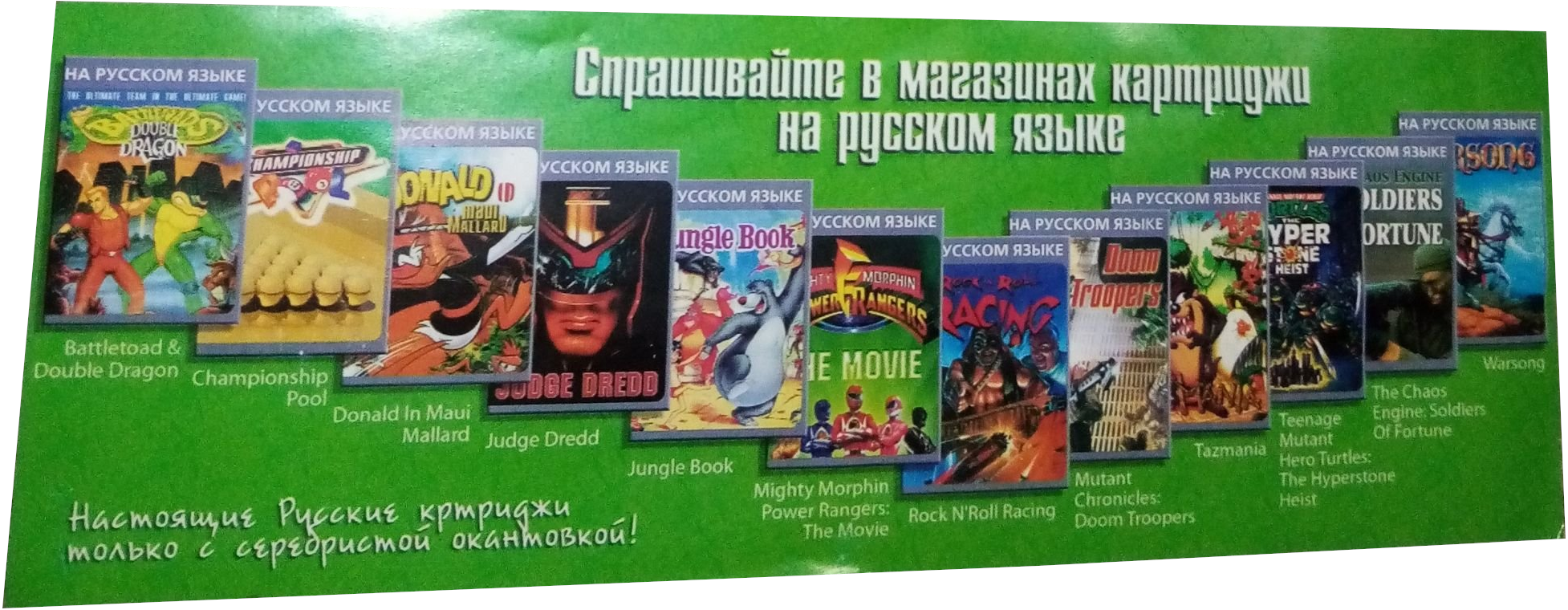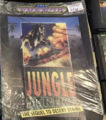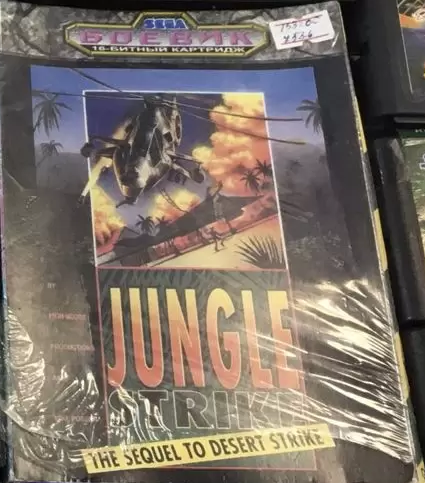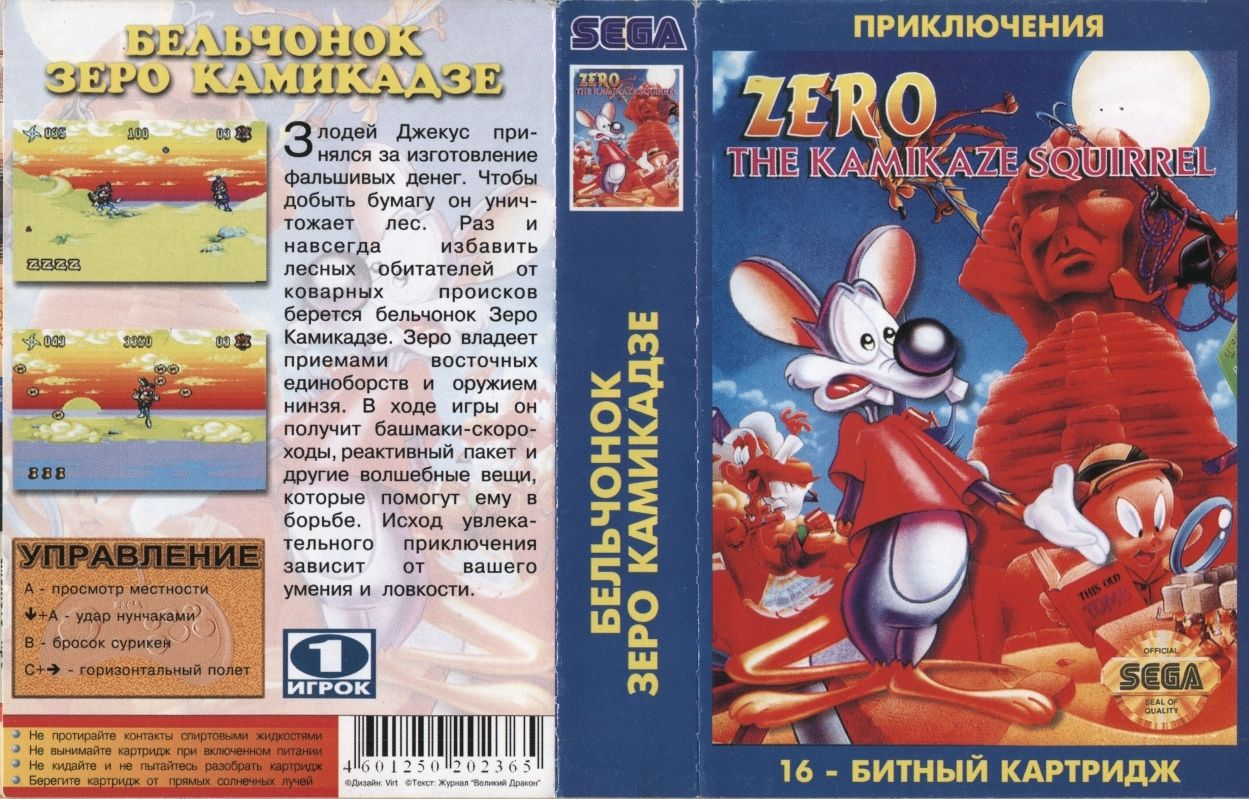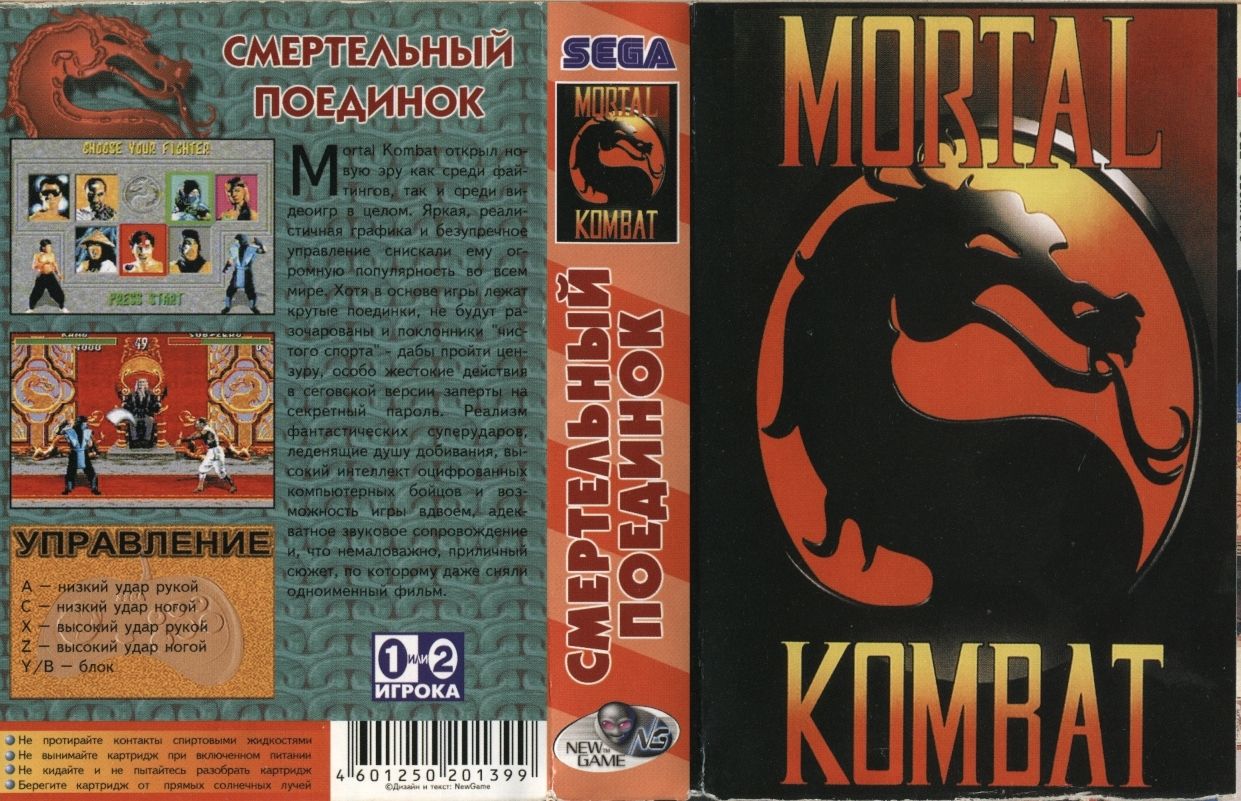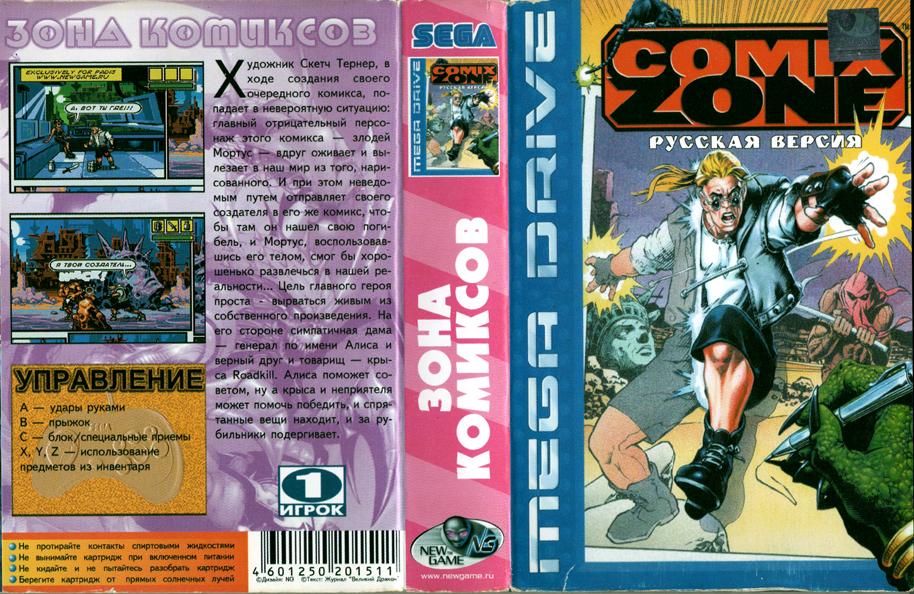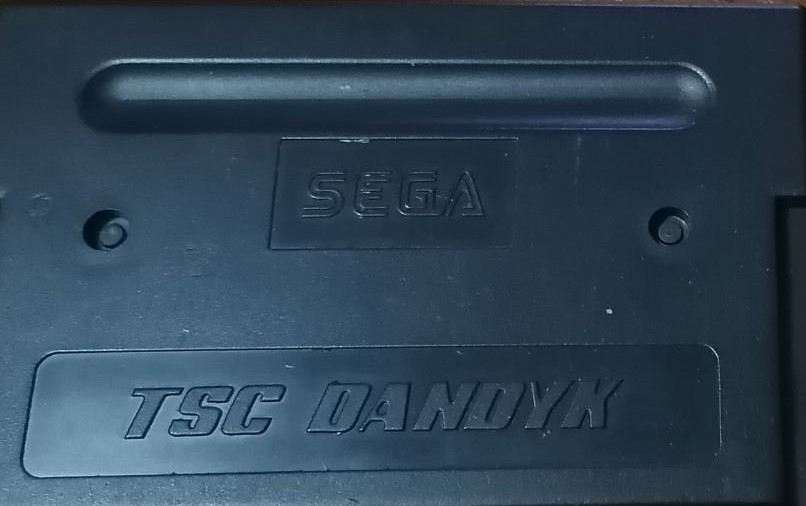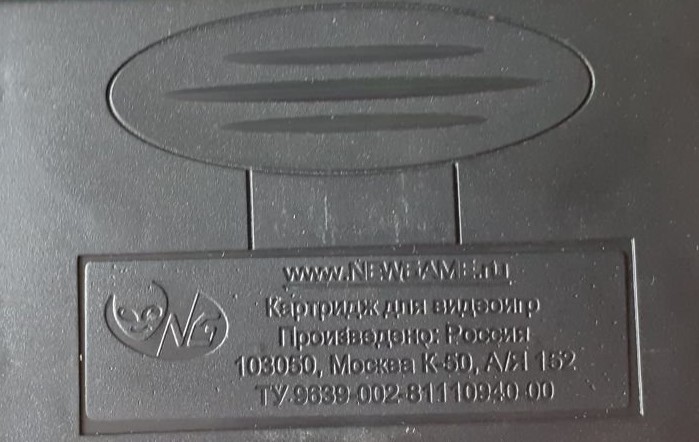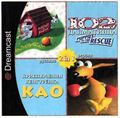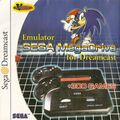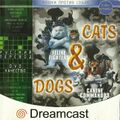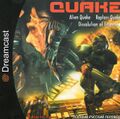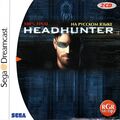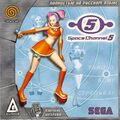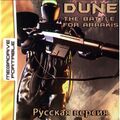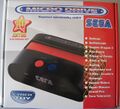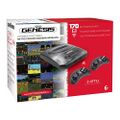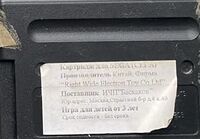Difference between revisions of "History of Sega in Russia"
From Sega Retro
m (→Dendy) |
(→SFRI) |
||
| Line 308: | Line 308: | ||
==SFRI== | ==SFRI== | ||
| − | In 2017, [[SFRI]] purchased all Constanta Plus trademarks including Mega Drive. However, the company hadn't released any new Mega Drive clone since 2017 and was selling only old ones. Despite this, other pirates on the market still tried to avoid breaking Russian law and didn't use the name Mega Drive in their copies.<ref>https://dtf.ru/gameindustry/77844-voyna-kopiraytov-pochemu-sega-mega-drive-mini-skoree-vsego-ne-vyydet-v-rossii</ref> Also legal releases | + | In 2017, [[SFRI]] purchased all Constanta Plus trademarks including Mega Drive. However, the company hadn't released any new Mega Drive clone since 2017 and was selling only old ones. Despite this, other pirates on the market still tried to avoid breaking Russian law and didn't use the name Mega Drive in their copies.<ref>https://dtf.ru/gameindustry/77844-voyna-kopiraytov-pochemu-sega-mega-drive-mini-skoree-vsego-ne-vyydet-v-rossii</ref> Also legal releases skip Mega Drive name, for example [[Sega Mega Drive - Nintendo Switch Online]] is known in Russia/CIS regions as ''16-битная классика от Sega''. It is worth mentioning that in 2019, Sega released the [[Sega Mega Drive Mini]], which wasn't sold in Russia for this legal reasons<ref>https://gamemag.ru/news/140019/sega-mega-drive-mini-russian-release-cancelled</ref>. However, the consoles could be purchased from importers and international distributors. SFRI had unexplained problems and was shut down between 2021-2022. |
==Baskakov== | ==Baskakov== | ||
Revision as of 17:00, 7 May 2024

|
| History of Sega in Russia |
|---|
| Official Sega distributor(s): Nissho Iwai (≥ 1990-1995), Buka (1994-1999), Bitman (1996-1997), R-Style (1996-1999), NVT (2000-2001), 1C-SoftClub (2005-present) |
The modern state of Russia (known officially as the Russian Federation), emerged as an independent state in December 1991, following the demise of the Soviet Union (USSR). The move from a one-party communist state to a more Western-style capitalist society, meant that luxary items such as video games were able to become more widespread. Sega has been involved in the region in various guises since at least 1990.
Contents
- 1 Sega Master System
- 2 Dendy
- 3 Forrus
- 4 Competition
- 5 Buka
- 6 Bitman and R-Style
- 7 PC Games
- 8 Game crisis in Russia
- 9 Mezhregional'naya obshchestvennaya organizatsiya sodeystviya proizvodstvu i realizatsii videoigr
- 10 New Game
- 11 BBG Electronics
- 12 Insta
- 13 Dreamcast
- 14 Mega Drive clones in early 2000s
- 15 Videogames Co. Ltd
- 16 Videoigra
- 17 Game Systems
- 18 1C-SoftClub
- 19 Constanta Plus
- 20 Portable market competition
- 21 Sega Amusement
- 22 Cyber Toy
- 23 K&S
- 24 Kartridzh Tsentr
- 25 Sititek
- 26 SFRI
- 27 Baskakov
- 28 Mega Drive clones today
- 29 References
Sega Master System
Residents of the USSR had contact with Sega for the first time in the Yuri Antonov song called Ot pechali do radosti from 1987 which contained clips from the Hang-On Jr..
Video games had existed in Russia during the days of the Soviet Union (Tetris being the most well-known example of a Russian video game export). The consoles were also present in the Soviet Union, and one of the first was "Palestra-02", produced in Ukraine since 1978, followed by many other Pong variations that were produced in many Soviet factories until early 1990s. Other example of video game system, was popular in late 1980s handheld called "Elektronika IM", a clone of Game and Watch, but virtually no Western video game companies chose to sell their products inside the bloc.
After Gorbachev's reforms in the second half of the 1980s, the situation changed and more Western culture began pouring into the USSR. Sega had a go at selling the Sega Master System (model no. MK-3096-19) inside the Russian SFSR from around 1990 with Nissho Iwai (a Japanese firm which had operated in Russia for decades) as company delivering them to state-run retail stores called Beryozka. The exclusive Russian Master System outputs a SECAM signal (for compatiblity with the Soviet TV standard), lacks both a card slot and reset button and have Alex Kidd in Miracle World built in much like redesigned Master System II console seen elsewhere.
Given its rarity, it is unlikely to have been a success. In 1994, Kunimasa Yagi, General manager of Sega admitted, that he was in Moscow in 1990, but then he saw no real conditions for effective promotion of products such as an appropriate distribution network or advertising support[1]. Same fate met BIT 70, the only famiclone that was distributed in USSR from around 1989, also by Beryozka[2].
Dendy
The end of the USSR in December 1991 caused some changes in the video game market in the newly established Russia. With the emergence of private enterprises, they began to import the consoles from Western Europe. More powerful systems such as Super Nintendo or Mega Drive were imported only in very small numbers[3]. The main attraction were older consoles from the first, second or third generations, which were lying in European warehouses and due to their age could be sold at a low price in Russia. The most commonly imported ones were Magnavox Odyssey, Intellivision, Atari 2600, Atari 7800, Nintendo Entertainment System, and simple portable video games produced by many companies at the time, such as Konami or Tiger. In the Summer 1992, as the market developed, certain stores began to offer not only the product itself but also the entire customer service, including full warranty and delivery of games wished by buyer. The most popular console among them was the Atari 2600, due to the fact that it was discontinued worldwide, but in Europe and Russia, games and machines were sold at a price lower than the production one[4]. The market stalls and flea markets were dominated by Rambo TV Game, an Atari 2600 clone that was imported shortly before the collapse of the USSR.
Russia's video game market is widely considered to have been created in December 1992, when Russian importing company, Steepler, created the "Dendy", an own-branded Nintendo Famicom sourced from Taiwanese manufacturers. At the time, no legislation existed in Russia to protect video game copyrights - while cloning games and hardware was both illegal in much of the world, the Dendy and its derivatives were perfectly legal in Russia - Nintendo could not stop the console's distribution, and didn't.
With a fully fledged marketing campaign, Steepler was able to dominate its home market, but the economical situation in Russia meant that Dendy was out of reach of most consumers, costing several months' worth of the average worker's salary (and indeed in 1993 it was estimated that 39-49% of the population was classed as being in poverty). Steepler were able to bring the costs down as the years went on however, bringing the console into a more affordable price range around 1994.[5]
Forrus
Steepler contacted with Sega of Japan about official distributon of Sega in Russia, but Sega sent him to Nissho Iwai which was a Sega partner here. Nissho Iwai wasn't hurry in negotiations and project failed.[6]
Nissho Iwai tried for a second time to create a distirbution network accross Russia with its own company Forrus who became the exclusive distributor. Sega would sell stock to Nissho Iwai, who would sell it to Forrus, who would distribute them to retailers across the country. In November 1993, Sega Master System II was released in European PAL format[7] (but first model was also seen as a prise in Sega's tv show). On November 14, Sonic - Super Hedgehog program was broadcast for the first time[8], which was weekly television show promoting Sega products, supported by on of the main chain store selling Sega - Mikrodin. Mega Drive II was released in April 1994 in European PAL version.[9] Until August 1994, Forrus had a network of 25 dealers only in Moscow, and sold Master System 2 for $56 and by retailers for $68-73, Mega Drive 2 sold for $119 and by retailers for $135-145 and games sold for $25-100.[10]
In August 1994, Kunimasa Yagi arrived at the headquarters of Nissho Iwai to present Sega's plans for Russia. He announced that Sega plans to sell 1 million consoles in 3 years and intends to have a 90% share in the Russian video games market. Kunimasa Yagi also said that promotion of consoles are limited due to numerous counterfeits on the market. As he said, most of the clones can be distinguished by the fact that they are in a white box in contrast to the original in black, and by the lack of Sega marking on some elements of the set[11][12] (like controllers).
Competition
Not content with just marketing Dendy consoles, Steepler used its position of market leader to market its Mega Drive. Its distribution channels and associated Dendy brand helped drive sales across the nation - at this point the Dendy was synonymous with video games in general, leading to curious situations were consoles would be referred to as "Nintendo Dendys" or "Sega Dendys". Steepler distributed its products around former republics of the USSR with chain of more than 300 dealers, giving it a territorial advantage over Forrus which until August 1994 had only sellers in Moscow.
Steepler began Sega sells with first generation of clones resembling classic Mega Drive: Pro 16 Bit and High Quality. With the time, company imported from Southeast Asia original Mega Drive 2 which was new at the time on the market and sold it in three variants: Green box, White with triangles box and self made English-Russian box. After that, clone producers introduced new generation of clones based on Mega Drive 2, so Steepler began to sold them as well, having now in it's stores old clones, new clones and imported originals. Of course, the stores had a large assortment of games from the USA, Asia and bootleg ones and to bypass the regional lockout, Steepler promoted use of Mega Key. Another new thing was Sega Genesis CDX imported from US also with games from there, which, due to its high price, has become a prestigious product in their stores. Products were promoted in Steeplers own media like Video Ace Dendy magazine, nationwide Dendy Novaya real'nost' TV program and regional Mir Dendy TV programmes.
Only in June 1994, Steepler sold 4,000 Mega Drives but planned to increase sales in the autumn from 10,000 to 15,000 per month.[13]Steepler decided to go further and registered the Mega Drive trademark on October 06, 1994.[14] This meant that according to Russian law, they had the right to sell Mega Drive despite Sega's disagreement. The trademark case would be repeated in Sega's history in this country it will be present even today.
Its Sega operations were cut short in November 1994, when Steepler was chosen as representative of the Nintendo in all former USSR countries. In Russia and CIS countries, the newly created AOZT Dendy company was selected as an exclusive distributor. While the agreement permitted the unlicensed Dendy consoles to be sold, sales of rival products (such as Sega) was restricted. It was established that AOZT Dendy stores won’t be selling original and clones of Sega products but Steepler could sell Sega normally.[15]Steepler leader said that he think, Nintendo made that rule, because it afraid that Sega would be more widespread in Russia.[16]Price of SNES was equal to price of Mega Drive II which cost around 420 000 RUB at the time. With help of Nintendo feeder for Eastern Europe from Austria called Stadlbauer Marketing[17], first delivery of Super Nintendo started on November 15 and a large advertising campaign was launched which resuted in 10,000 consoles sold by the end of the year. In December 1994, there was only one Mega Drive for every three Super Nintendo consoles sold.[18] Unfortunately, only a small part of the games reached the distributor, so most customers bought only consoles without games. In January, the promised rest of the games arrived. Nintendo delayed the next delivery of consoles by up to two months. Because of this, AOZT Dendy didn't have any goods to sell, so it was decided to negotiate a new contract with Nintendo and permission to sell Sega consoles was given.[19]Lots of internal and external problems in Steepler was a reasone, why they declared bankrupt in 1996.
Second major competitor was Subor, a Chinese company that produced and distributed products in Russia itself through its representative office established with the help of the Chinese government in Moscow.[20]Subor released it's own clones of the Famicom at a price lower than the cost of production, which undermined 8-bit Dendy's sales beetwen 1994-1995.[21] They also manage to sell family of Sega clones called SB-16 and most widespread of them was SB-16C model. Of course, the company sold bootleg copies of Sega games.
Third major competitor was Kenga, another manufacturer of Famicom clones, active from autumn 1994, that released Sega clone named Mega-Ken[22] which was distributed in Russia by Kenmaster with full support from Lamport (a company that split from Steepler in 1994). Kenga promoted it's brand, creating Ken-Club, Ken-Card and it's own TV show. Like others, Kenga promoted it's own bootleg copies of games.
Fourth major competitor was Bitman, established in November 1994. In addition to marketing Famicom and Game Boy clones, the company launched its own two Mega Drives, called Super Bitman and Turbo Bitman along with bootleg copies of games. Products were sold with full support of R-Style retail chain.
From 1994, Russian company Teplostar produced Fugi Star Drive and later it's successor Fugi Star Drive 2, but despites the fact of domestic manufacturing, rather than importing it from Asian factories like the rest, the clone wasn't popular.
Other competitors included consoles like Magic 2 and other ones which were sold by smaller retailers without as much knowledge of advertising or market competition as the five companies above. The true number of smaller organisations selling clones, bootleg games or imported stuff is not known.
Unlicensed accessories like Interceptor Mega Disk[23] or mentioned earlier Mega Key were also distributed.
Buka
Demand for Mega Drive consoles continued to grow, as did the number of clones available. During his stay in Russia, Yagi concluded that it is still impossible to fight counterfeits with legitimate methods and admitted that Sega would fight clones by high quality and low prices. Several strategies have been taken to combat this phenomenon. In Autumn 1994, Nissho Iwai selected Buka as the official distributor.[24] The second step was getting along with Steepler and AOZT Dendy to sell the original Mega Drive II and games. Now they sold original Sega, but they also had clones in the stores that had lower price than original, so Sega release Asian version of Mega Drive II, cheaper than the European one (this model was still on sale as a bundle with 2 pads and Sonic 2) and as a result, in mid-1995, Steepler sold European Mega Drive II with Sonic 2 for around 650 000 RUB, Asian Mega Drive II for around 530 000 RUB[25] and clone consoles for around 430 000 RUB[26]. Super Nintendo cost around 650 000 RUB and Steepler complained that consoles and games are more expensive than bootleg or even original Sega, but on the other hand said that SNES doesn’t had competition from clones and pirate software like Mega Drive.[27]
In late 1994, Mega CD II (sold there in Asian and European PAL) and Game Gear were delivered to Russia. In March 1995 the Mega Drive 32X (sold there in Asian and European PAL) was released and the sale of the first Sega Saturn models imported from Japan began.[28] Until early 1997, Buka had created retail chain of 500 partners selling products in Russia and CIS.[29] Several games had a manuals in Russian, such as Sonic 2, ExoSquad, Primal Rage[30] and Ecco the Dolphin 2[31].
In 1995, 30% of the Sega consoles sold in Russia were clones. The consoles sold by Bitman and Kenmaster had each 10% of sells on the market.[32], but after a while, two of Sega's biggest rivals disappeared from the market. In 1995, Sega got along with Kenga to distribute Sega Multi Mega and in the late 1996, Kenga decided to move on from selling console to opening a chain store with childern toys. In Januar 1996, Bitman get an agreement with Sega Europe about an official distribution. Despite the large piracy, Sega said that Mega Drive had good sales in Russia.[33]
Besides Famicom and Mega Drive clones, Sega had competition in form of Super Nintendo and Game Boy (distributed from November 1994 by Steepler[34]), 3DO (distributed from late 1994 by Buka), PlayStation (distributed from March 1995 by Buka[35], which distribution was taken over from September 1996 by Sony CIS[36]), CD-i (distributed from 1995 by A –STIMUL[37] with chain of 3 authorised distributors) and Atari Jaguar (distributed from 1995 by Game Land).
An interesting fact is that Sega 16-bit was used in some Russian hospitals as biofeedback (learning to control body functions that normally can't be controlled by a ill person) and was called 'Bio-Bitman' consisting of Dendy, Bitman or Mega Drive II and EMG-BOS Myotonic-03. Doctors used it for children over 5 years old and teenagers as rehabilitation, using the games like Ayrton Senna's Super Monaco GP II and Tom and Jerry. Playing these games required the involvement of the appropriate muscles, which was supposed to have a positive effect on the therapy of certain neurological diseases.[38]
also published in:
- Velikiy Drakon (RU) #20: "xxxx xxxx" (1995-10-01)[39]
- Velikiy Drakon (RU) #21: "xxxx xxxx" (1995-11-27)[40]
also published in:
- Strana Igr (RU) #1 (1996-xx-xx)[41]
Bitman and R-Style

To act even more effectively against piracy Sega has chosen a second distributor. After one year of negotiations, in January 1996, an agreement was signed under which the Russian company Bitman became the distributor No.1 of Sega Europe in Russia and the CIS countries[42] With its own chain of stores, Bitman was able to distribute the Mega Drive 2, Sega Saturn, Sega Mega-CD 2, Sega Game Gear, Mega Drive 32X and Sega Pico[42] in addition to the Super Bitman (which was called now the official clone)[43] all in the European PAL system with Buka as distributor No.2 and R-Style as distributor No.3.[44] At a joint press conference on June 6th, 1996 this fact was officially confirmed and detailed plans for distribution were presented. Press releases stated that "The Bitman-Sega strategic alliance will lead Russia into the information future."[45] At the conference, it was announced that Sega products will be available for purchase with a one-year warranty and with a certificate of the Russian State Standard GOST. Saturn has also been announced as the main gaming system, but the demand for the affordable Mega Drive II and Pico is also strong.[46] The prices of consoles were very close to the prices of clones[47], which undoubtedly had a positive impact on the competitiveness of products. In 1996, CEO of Bitman said that 50% of consoles sold on the Russian market were from Sega, but 35% were either mostly Chinese fakes or official clones (Super Bitman).[48]
In March 1996, the Russian version of Sega Pro was released. Unofficial importers released Sega Nomad and Mega Jet in the same year.[49]
About a year or two (late 1995/early 1996) after Steepler registered the Mega Drive name, Sega Europe, which replaced Nissho Iwai/Forrus, had already seriously started building its representation in the region, contacted them about the trademark seizure. The case ended up for both side neutral, with Steepler not interfering with Sega's domestic distribution, and Sega not claiming the trademark.[50] Despite the end of Steepler in mid-1996, trademark was register by Steepler Investment in April 11, 1996[51] and AOZT Dendy chain store still existed until 1998, continuing sells of Sega Saturn and different versions of Mega Drives.
After the success of Mega Drive, Sega had high hopes for the distribution of Sega Saturn. The Russian and CIS markets have become a priority among former Eastern Bloc countries.[52]The European version of the console could already be bought from official distributors since January 1996, but full retail sales in other stores began in May 1996. Despite the efforts of Buka, Bitman and R-Style, Sega Saturn just as in other countries of the world didn't sell as good as Mega Drive. Game Land said that Sega Saturn, PlayStation and Nintendo 64 (distributed from October 10, 1996[53]) sold only 20 000 units together in Russia in 1996.[54] Game Land and Buka said that 1996 was year that 8-bit and 16-bit were driven out from the Russian market and replaced by 32-bit systems[55], but this was only a theory. CEO of Bitman said in May 1997, that 8-bit systems were in fact pushed out from the big cities, 3DO has ended its lifespan and there is practically almost no new licensed products for 16-bit systems like Mega Drive II.[56]
Soviet Strike is the only known game for Saturn that had translated back of the box into Russian and Dobro i Zlo was supposed to be only game for this system with Russian name.
On August 11, 1997, a non profit organisation called Anti-Software Piracy Association (RASPA) was found in order to fight piracy in Russia and CIS region. One of it's founders where Buka and Bitman, which resulted in adding Sega to group of the companies protected by organisation[57].
In December 1997, the Bitman was acquired by R-Style, who extended Sega's distribution agreement[58]. It was established that Sega Europe will supply to two remaining distributors Sega Saturn[59] and Pico[60], because only these systems were still supported in Europe. Remaining units from Bitman distribution of European Mega Drive II and Mega-CD II will be available until last stocks are gone, while R-Style will continue sells on still strong 16-bit market on it's own with new KW-503 version of Super Bitman that was firstly introduced to Russia in late 1996/early 1997, still with permission from Sega. As before, Buka doesn't sell the clone, but has stocks of Mega Drive II from Asian distribution, which unlike Europe is still support on Asian market.
According to the Russian Great Dragon, there were several hundred thousand Mega Drive consoles in Russia as for June 1998[61]. While this figure most likely includes the original Mega Drive and some known clones, it isn't probably a complete picture of the number of consoles in this country especially since many of the smaller clone brands weren't sold in an organized manner.
Some stores began importing quite exotic Mega Drive accessories and variants like Aiwa CSD-G1M.[62]Very few specialized video game stores had Game Gear multicarts[63] and Saturn bootleg CDs.
also published in:
- Strana Igr (RU) #25: "Iyun 1998" (1998-xx-xx)[64]
PC Games
The Russian PC market for many years was under strong piracy pressure. The compilations that contained many games on one disk appeared as the first but then came Russian pressed bootlegs that became very popular in the former USSR countries and in former Warsaw Pact countries such as Poland. This games had covers in Russian and at the beginning many people thought that this were original games due to its more professional presence than regular bootlegs. Along with their popularity, the first illegal translations of games into Russian appeared in late 1990s/early 2000s. Known companies that distributed these bootlegs are 7th Wolf, Fargus Multimedia, Torum Media, Triada etc. With the time, Sega games for other platforms such as PlayStation 2, Game Boy Advance or Xbox had also been illegally translated.
Game crisis in Russia
In 1998, the economic crisis began in Russia. Original games began to cost huge money. This resulted in a very high level of computer piracy (95%). Pirate titles were widely available, within a few days of their release, outside of every Moscow metro station.[65] Many realized that official distribution has no future in Russia.
As a leading software publisher in Russia, the CIS and the Baltic States, Buka has seen this problem since it was founded in 1993 and used various methods to limit its impact.[66] They decided to take a risky step, releasing two versions of games, a full box version with instructions (and a small surprise), as well as a cheaper version in the jewel case to compete with pirates in terms of price. The customer has chosen a legal product.[67]Although piracy still existed, the government and other companies tried to fight it.
Mezhregional'naya obshchestvennaya organizatsiya sodeystviya proizvodstvu i realizatsii videoigr
From around 1997, Simba's Video Games known from releasing Famicom clones and official accessories for PlayStation, began selling simple clones called Sega Mega Drive 2. In early 1999, Simba's began promoting new Mega Drive clone called Simba's 168. Later that year, Mezhregional'naya obshchestvennaya organizatsiya sodeystviya proizvodstvu i realizatsii videoigr (Interregional public organization for the promotion of the production and sale of video games) associated with BBK Electronics[68] bought the rights to the Mega Drive name and began selling consoles and accessories under the brand Mega Drive with Simba 's like Vzlomshchik Kodov, Mega Drive 2 (same as version from 1997 but without Sega logo) , Mega Drive 4 (clone console) and others.
Around that time, Gastin released Mega Drive translated box into Russian. Later, Simba's released them again with different screenshots on the back of box and without Gastin's name, continuing to use the same design pattern for a new releases. In later years, Simba's participated in a project of translating Sega games into Russian and until 2004, about 200 games were translated.[69]They released translated games in so called "Silver" release from mid-2000s and "Gold" release from early 2010s.
also published in:
- Entsiklopediya luchshikh igr Sega. Vypusk 1 (RU) #1: "" (1999-xx-xx)
- 730 igr dlya Sega (RU) #1: "" (1999-xx-xx)
also published in:
- Entsiklopediya luchshikh igr Sega. Vypusk 5 (RU) #1 (200x-xx-xx)[70]
New Game
Around 1997/1998, Padis has released new clones called Mega Drive 2. This were simple copies of the Asian versions of the Sega 16-bit console. They had a Mikki sticker on the package (it was a store related to Padis). The next one were Mega Drive 3 and Game VCD (with registered trademarks for Mega Drive 3 and Game VCD) [71][72]When Simba's began to manufacturing the clones of Sega with registered Mega Drive name, Padis changed to New Game and named it's clones Magistr Drive to avoid problems with the use of Mega Drive name.[73]In the next years, New Game registered trademarks for Aladdin[74], Zero Tolerance[75],Robocop[76], Chase H.Q[77], Superman[78], Bugs Banny[79], Sylvester and Tweety[80], Pirates[81], Flinstones[82], Jungle Book[83], Asterix[84], Mortal Kombat[85], World of Illusion[86], Ariel Mermaid[87], so they could sell games with these names and their sequels 'legally' on Mega Drive. In later years, New Game created its own club and organized games competitions where players could win accessories, games and consoles.[88][89]
The company also started releasing games in their packages translated into Russian probably from 1998 in the series 16 Битный картридж. The design of the boxes was created by the Virt, whose trademarked was registered by Padis.[90] The first game translated to Russian was simple game called Monopoly, back in 1998, but New Game began bigger translation of rest Mega Drive games into Russian at the beginning of 2000s, by themself (Padis) or with help of third groups like Shedevr or MagicGame. Over the next few years, New Game re-released translations multiple times. Text on some of the covers was made by Great Dragon magazine.
Additionally, the 16 Битный картридж series cartridges were made by TSC Dandyk. TSC Dandyk started in the 90s. Shop in Omsk called TSC Dendyk sold games and consoles. At one point, the owner started making his own cartridges for the Dendy console. The forms for these cartridges were sent from China but the Chinese made a mistake and they write TSC Dandyk. Thus, the games were produced and distributed in other regions of Russia and later other CIS countries such as Kazakhstan. The same thing happened with the Mega Drive cartridges. Although the Dendyk shopping center was closed, the form for making games was bought by another person in Omsk and the TSC Dandyk mark still existed in the 2010s.[91]
also published in:
- Velikiy Drakon (RU) #57: "xxxx xxxx" (2002-02-05)[92]
BBG Electronics
BBK Electronics or BBG Electronics released the Subor consoles under the Liko brand. In addition to the famiclones, there was also a Mega Drive clones like Liko BBG-688. Mezhregional'naya obshchestvennaya organizatsiya got along with BBK and in addition to buying their trademark, they started selling their electronics and BBK started producing counterfeit Mega Drive consoles for them (in most models it is written that Simba's created them). In later years, Simba's made a deal with Zoga to manufacture Mega Drive clones, so around 2003-2004, BBG began selling its own counterfeit Mega Drive with bootleg games under the brand Magic Drive.
Final Fantasy under Magic Drive brand
Insta
Insta was another company that distributed translated Mega Drive boxes into Russian in late 90s/early 2000s.
NHL 97 from Insta
Dreamcast
In 2000, NVT was appointed a distributor of Sega in Russia and CIS[93]. Sega Dreamcast was presented in Russia on Comtek 2000 which took place from 17 to 21 April 2000.[94][95] Initially, Sega promised to localize games into Russian and distribute games in cheaper jewel cases (which PC games distributors like Buka done it from 1998), but this did not materialize due to hard situation of Sega around the world, so they stay with the idea of delivering games in European versions. On November 10, 2000, the distributor began pre-release selling of the console and promised its official release at the end of the year.[96] The consoles were supposed to be purchased in a few retailers like Noviy Disk, Game Land etc. Unfortunately, larger plans for the sale and its marketing were not implemented after NVT got information from Sega that they were ending production of the console on January 31, 2001 and stopping shipments of the Dreamcast to Russia and CIS.
Even before that, there were imports of the Sega 128-bit console, first from Japan, then from the US, next from Europe, and the last one being the most widespread, costing $350 in around May 2000.[97] The end of 2000 was marked by a boom for DC consoles in the CIS countries, which was related to the mass distribution of Russified versions of games (pirated ones).[98] With the popularity of the console, several local distributors decided to buy official consoles directly from Sega and sell them on their own. It happened in 2001–2002 when Big Ben Interactive became a distributor in Western Europe. Local distributors bought consoles cheaply from them and began to distribute Dreamcast along with self made instructions in Russian with the price of $159.[99] Despite the failure of Dreamcast in the world, in the CIS countries the console was well received and could be bought easily with games even in 2003 and 2004 for max 4000 RUB.[100] Some specialized stores had this console and games for sale until 2007.
The Dreamcast's popularity in Russia was caused, as in the case of the Mega Drive, by piracy. When the first bootleg games appeared, they only had a box translated into Russian, but after time, translations of entire games into native languages became more and more popular. These were versions with subtitles and a translated interface, but some games also had versions with full Russian dubbing. The games were distributed with custom-made packaging and distributed through wholesalers in Russia and CIS countries. There is a list of known companies that translated and sold pirate games:
- Vector (Вектор)
- Kudos
- RGR Studio
- Paradox
- Playzero
- Pinachet Game
- Nautilus
- Studia Max
- Playbox
- RED Station
The pirates also released a few additional programs such as emulators of other consoles like Game Boy or Mega Drive[101], Internet Media Disk or VCD Player. A major contribution to the creation of unofficial accessories was made by Simba's Video Games, which created devices like Memory Card (Simba's), CD Loader or Nexus. Their store sold a official Dreamcast console with bootleg games and they themselves advertised their website called Dreamarena.ru where visitors could learn for example how to run the internet on the console using telephone lines or the Dreamcast Web Browser. They used the same name to promote series of book about the Dreamcast called DreamArena.
Several pirates came up with the idea of distributing movies for the Dreamcast console in special packages, translated into Russian. One of such company was videodisc.ru.
In mid-2000s, the war against piracy in Russia intensified, and thus many companies specializing in this field decided to go underground or became legal distributors and translators of games. Of course, these changes affected the most recent software mainly for PC, PlayStation 2 and distribution of movies, the old Dreamcast wasn't affected by the changes as much. This changes didn't matter for Mega Drive clones.
Half Life prototype sold by Vector
Headhunter from RGR Studio
Space Channel 5 with Russian dub from Kudos
Mega Drive clones in early 2000s
When Dreamcast was distributed in Russia, Mega Drive clones became the most popular gaming consoles on Russian market, overtaking even Dendy. Given the availability and wide selection of cheap game cartridges now translated into Russian by pirates, they were still a welcome gift for schoolchildren.[102] The most popular were Mega Drive 4, Simba 268, Magistr Drive 5 and Mega Drive X. New among these clones were educational consoles, which according to the producers, in addition to the games, taught foreign languages.[103]These consoles included a special learning software cartridge, and some stores sold additional programs. One of the first ones was created on the initiative of the New Game company and they were Magistr 16 and Magistr 16 Bakalavr. The breakthrough for Sega computers was around 2003 when BSComp released CyberShell and then CyberSmart. These consoles became the basis for other consoles of this type. New Game was first selling CyberShell and later developed its own clones called Magistr Aspirant and Magistr Litseist. Also, sets of educational consoles from Simba's Video Games (Kibord-005 and Kibord-007) have things from Cybershell. The Magic Drive series created their own version of educational console called Magic Teacher GS-200N.
Videogames Co. Ltd
In January 2000, Videogames Co. Ltd. (OOO Видеоигры) was founded,[104] which started selling Mega Drive clones under the Maniac Drive brand.
Videoigra
In July 1999, Videoigra (ООО "Видеоигрa) was found[105]. The company was known from creation of different CD tools for Dreamcast and PlayStation like Game Guru series, distributed by Simba's. In 2004, they bought the rights to the Mega Drive and Simba's name, but did not use them for too long, especially since they lost them in 2006.[106]
Game Systems
From around 2004, Game Systems began producing and distributing Sega clones such as Sega Driver, Sega Dolphin II, Sega Dream Master II, Sega Favorite, Champion and Mega Dream were created. The last one was sold in the Simba's Video Games store chain.
1C-SoftClub
In 2005, SoftClub became a distributor of Sega in Russia and CIS, which became a part of the company 1C. More modern games for the PlayStation 2 and beyond seem to be distributed in Russia legally without much concern. The country seems to have adopted the PEGI rating system and games are translated officially into Russian in a similar manner to other European regions, however in 2012, Russia adapted its own game rating system.
From 2004 to 2006, Akella localised certain Sega's titles.
The only Sega game that distribution has been stopped in Russia was Company of Heroes 2.[107]
On March 2022, Sega suspended sales of products and services in Russia.[108]
Constanta Plus
In 2006, the rights to the name Mega Drive were sold to Constanta Plus. Company still cooperated with Simba's Video Games, whose trademark they bought[109] and with Zoga. All devices released so far such as Mega Drive 2, Mega Drive 3, Mega Drive 4, Mega Drive X, Mega Drive V, Mega Drive Extreme, Simba's 268 and Vzlomshchik Kodov have been released once again with box changes. New thing was a series of devices called Mega Drive Portable[110]whom steal design tips from Nintendo consoles. Games were placed in custom-made Game Boy Advance-style cartridges which mean that they aren't compatible with regular Mega Drive, but only with MDP. In 2011, Simba's Video Games joined the Proyavlyay Emotsii group[111], which also sold eMote and EXEQ consoles which are portable emulators of Mega Drive. All consoles were exported to other CIS countries. In 2011, Mega Drive Junior series was released and in mid-2010s, production was moved to Star Games Electronics Co., Ltd which still produced Mega Drive Junior, Mega Drive X and Mega Drive 2.
Dune 2 box as Mega Drive Portable game
Portable market competition

Mega Drive Portable, eMote and EXEQ had competition in form of DVTech Discovery released in 2008[112] and distributed by New Game, !QU[113], SD Portable[114] and MDPortable distributed by Krash with help of K&S.
Sega Amusement
ODA distributes Sega arcades in Russia from at least late 90s.[115][116]
Since 2006, the distribution of arcade machines and equipment for children in Russia/CIS produce by Sega is being carried out by KidsPlay.[117]
Since 2011, QubicaAMF is a strategic partner in Russia and CIS countries.[118][119]
Cyber Toy
Around 2007, BSComp Ltd established Cyber Toy and began working with AtGames. Thanks to that good chunk of their consoles have been released in the region, including the Arcade Classic (as Sega Mega Drive Igrovaya Pristavka), Arcade Ultimate (as Gopher) and Genesis Gencore (as Sega CyberSmart). Blue and green versions of the Arcade Ultimate appeared in Russia before other regions of the world (namely the UK, in which Blaze Europe introduced the blue variant in 2011), suggesting strong support from AtGames in that region. Micro Drive was exclusive to Russia.
Cyber Toy got official rights from Sega to sell Pico in the region. They also had premission to sell it's own CyberShell clone[120].
K&S

In 2004, Kudos working now as K&S began to deal with sale of games for Mega Drive.[121][122] In the late 2000s/early 2010s, K&S began distributing its own Super Drive consoles (also known as Sega Drive) with its own video game bootlegs and began distribution of Chinese Hamy consoles on the Russian market starting with Hamy 2, all through few sites like segagames.ru, crashgames.ru, segadendy.ru and others. In 2009, they created Krash company that handled marketing of portable consoles like released year earlier MDPortable.[123][124]
Kartridzh Tsentr
From around 2011, AtGames began working with Kartridzh Tsentr.[125] The company continued to work with Cyber Toy to distribute their licensed products such as Micro Drive and Micro Drive Festa but also released licensed AtGames products such as Arcade Ultimate in 2011 as Gopher and Arcade Motion Dual in 2013 as Sega Genesis Nano Trainer.[126] In addition, since 2017, the company has been distributing its own Sega consoles under the name Retro Genesis.[127]
Sititek
Sititek is the official distributor of Sega Toys in Russia and CIS countries.[128]
SFRI
In 2017, SFRI purchased all Constanta Plus trademarks including Mega Drive. However, the company hadn't released any new Mega Drive clone since 2017 and was selling only old ones. Despite this, other pirates on the market still tried to avoid breaking Russian law and didn't use the name Mega Drive in their copies.[129] Also legal releases skip Mega Drive name, for example Sega Mega Drive - Nintendo Switch Online is known in Russia/CIS regions as 16-битная классика от Sega. It is worth mentioning that in 2019, Sega released the Sega Mega Drive Mini, which wasn't sold in Russia for this legal reasons[130]. However, the consoles could be purchased from importers and international distributors. SFRI had unexplained problems and was shut down between 2021-2022.
Baskakov
In April 2023, Mega Drive trademark was bought by Baskakov Pavel Vladimirovich[131], the founder of Padis/New Game, the longtime distributor of the Magistr brand, previously featured in this article, and holder of the Dendy trademark since 2012.
In November 2023, Baskakov announced that it is seeking legal action to partially remove the legal protection of the Sega brand and logo in Russia. The reason is that they aren't use by Sega (because of leaving the Russian market in March 2022). If the rights are granted to Baskakov, it could create a problem in the official distribution of anything Sega owns[132].
Mega Drive clones today
Since the end of 2010s, there has been a sharp increase in interest in Sega clones in Russia. In 2019, Sega and Dendy clones had 18% shares in sales of consoles in Russia.[133] The main reason for this may have been the growing interest in retro consoles released by Nintendo, Sega and Sony in the world[134].
In the mid 2010s, new Sega clones appeared, which in addition to built-in several hundred games for Mega Drive also have built-in games for Dendy/Famicom. Such consoles are, for example Titan, MixHD and some new versions of consoles from the Magistr Drive or Dendy brands. This trend is becoming more and more popular but simple clones that launch only Mega Drive games are still being made. Clone producers are uploading, in addition to Dendy and Sega games, also other systems, and consoles such as Nimbus Smart, which apart from 16-bit Sega and 8-bit Nintendo games also has software for Neo Geo and MAME. In 2020, the Titan 3 console took 5th place in the number of consoles sold on the Russian market in the January-September period.[135]After the Nintendo, Sony and Microsoft consoles left the Russian market, sales of the Sega and Dendy clones have increased rapidly since April 2022.[136] For example, in June 2022, many stores reported that the percentage of purchased 8-bit and 16-bit consoles increased, compared to a year earlier, and the most popular from Sega brand were Game Box, Magistr Mega Drive (250 games built-in), Retro Genesis (300 games built-in) and the choice was guided by the price of the console and the presence of an HDMI input.[137]
The demand for cartridges is decreasing year by year. Starting from 2000s, the first Sega clones with built-in games appeared. Initially, there were only a few games, then a dozen and the latest consoles already have several hundred built-in games. There is still possible to find companies producing cartridges in Russia (such as GeymKard[138]) or importing them from China (such as Baskakov).
References
- ↑ Магазин Игрушек 1/95 Sega российский рынок-этo серьезно
- ↑ https://bookers.tech/post/cadaba99-3189-47f0-ac93-34295cf18be3/
- ↑ https://www.kommersant.ru/doc/65101
- ↑ https://www.kommersant.ru/doc/44974
- ↑ http://tv-games.ru/wiki/Companies/Steepler.html
- ↑ https://vc.ru/flood/28217-ya-boyalsya-chto-nazvanie-budut-chitat-kak-dendyu-intervyu-s-sozdatelem-brenda-dendy
- ↑ Магазин Игрушек 1/95 Sega российский рынок-этo серьезно
- ↑ https://web.archive.org/web/20210510221204/http://tvp.netcollect.ru/tvps/czqhuukeevjv.jpg
- ↑ Магазин Игрушек 1/95 Sega российский рынок-этo серьезно
- ↑ https://www.kommersant.ru/doc/10153
- ↑ https://www.kommersant.ru/doc/10153
- ↑ Магазин Игрушек 1/95 Sega российский рынок-этo серьезно
- ↑ http://tv-games.ru/wiki/Companies/Steepler.html
- ↑ http://tmregister.ru/trademarks/74180-c9a0c10300c4c86eb02407c18581ff26
- ↑ https://www.kommersant.ru/doc/94004?query=steepler
- ↑ https://vc.ru/flood/28217-ya-boyalsya-chto-nazvanie-budut-chitat-kak-dendyu-intervyu-s-sozdatelem-brenda-dendy
- ↑ File:CTW_UK_586_Europe_Supplement.pdf, page 1
- ↑ https://www.kommersant.ru/doc/103410
- ↑ https://secretmag.ru/business/trade-secret/nintendo-so-slonom-kak-viktor-savyuk-pridumal-pristavku-dendy.htm
- ↑ https://vc.ru/flood/28217-ya-boyalsya-chto-nazvanie-budut-chitat-kak-dendyu-intervyu-s-sozdatelem-brenda-dendy
- ↑ https://vc.ru/flood/28217-ya-boyalsya-chto-nazvanie-budut-chitat-kak-dendyu-intervyu-s-sozdatelem-brenda-dendy
- ↑ https://archive.aif.ru/archive/1643867
- ↑ https://www.youtube.com/watch?v=1C5GhtR84v4&ab
- ↑ https://archive.org/details/Korona_Video-Ass_03/page/n37/mode/2up
- ↑ https://www.youtube.com/watch?v=uxY9D-9k4zs&list=PLilc6-ICNoeXveLBeilZOCoXpOuF8gbP_&t=180s&ab
- ↑ https://vk.com/dendynn?z=photo-61601486_457247144%2Falbum-61601486_267327344
- ↑ https://vc.ru/flood/28217-ya-boyalsya-chto-nazvanie-budut-chitat-kak-dendyu-intervyu-s-sozdatelem-brenda-dendy
- ↑ Бука - Магазин Игрушек 1/95 page 57
- ↑ https://web.archive.org/web/19970414061531/http://www.buka.ru/profile/profile.htm
- ↑ Buka price list from June 30, 1997
- ↑ Buka price list from April 14, 1997
- ↑ Магазин Игрушек 4/95 page 49
- ↑ https://www.telecompaper.com/news/32-bit-consoles-to-be-launched-in-may-1996--81064
- ↑ https://www.kommersant.ru/doc/94004
- ↑ Бука - Магазин Игрушек 1/95 page 57
- ↑ http://web.archive.org/web/19980703064424/http://www.playstation-europe.com/playstation/pr/launch.htm
- ↑ http://zhurnalko.net/=sam/junyj-tehnik/1995-07--num57
- ↑ https://twitter.com/Pixel_Devil/status/1463849952413720577 Yuriya Gol'dblata "Osnovy reabilitatsii nevrologicheskikh bol'nykh" - 2017
- ↑ Velikiy Drakon, "xxxx xxxx" (RU; 1995-10-01), page 5
- ↑ Velikiy Drakon, "xxxx xxxx" (RU; 1995-11-27), page 5
- ↑ Strana Igr, "" (RU; 1996-xx-xx), page 53
- ↑ 42.0 42.1 File:Migr_8_RU.pdf, page 91
- ↑ https://www.kommersant.ru/doc/233963
- ↑ File:CTW_UK_586_Europe_Supplement.pdf, page 3
- ↑ https://www.osp.ru/cw/1996/23/12306
- ↑ https://www.itweek.ru/themes/detail.php?ID=38474
- ↑ https://web.archive.org/web/20161230180542/http://game-exe.org/index.php?n=Exe.Exe008Bitman
- ↑ https://www.kommersant.ru/doc/233963
- ↑ Strana Igr 8 page 13
- ↑ https://vc.ru/flood/28217-ya-boyalsya-chto-nazvanie-budut-chitat-kak-dendyu-intervyu-s-sozdatelem-brenda-dendy
- ↑ https://findtm.ru/card/12/120580.html
- ↑ https://www.telecompaper.com/news/32bit-consoles-to-be-launched-in-may-1996--81064
- ↑ Gameland 9/96 page 73
- ↑ Strana Igr 12 page 10-14
- ↑ Strana Igr 12 page 10-14
- ↑ Strana Igr 12 page 10-14
- ↑ https://web.archive.org/web/20000816000704/http://www.elspa.ru/start_e.html
- ↑ https://www.itweek.ru/themes/detail.php?ID=44981
- ↑ R-Style - Strana Igr 19 Dekabr 1997 page 19
- ↑ R-Style - Strana Igr 19 Dekabr 1997 page 19
- ↑ Velikiy Drakon 39 page 46
- ↑ https://www.youtube.com/watch?v=gwV9bZYXQPs&t=570s
- ↑ http://www.greatdragon.ru/online/38/1676-389091-postoyannye-chitateli-zhurnala-velikiy-drakon.html
- ↑ Strana Igr, "Iyun 1998" (RU; 1998-xx-xx), page 15
- ↑ https://web.archive.org/web/20010303023345/http://www.buka.com/local/piracy.htm
- ↑ https://web.archive.org/web/20010303023345/http://www.buka.com/local/piracy.htm
- ↑ https://web.archive.org/web/20010303023345/http://www.buka.com/local/piracy.htm
- ↑ https://dtf.ru/gameindustry/77844-voyna-kopiraytov-pochemu-sega-mega-drive-mini-skoree-vsego-ne-vyydet-v-rossii
- ↑ https://web.archive.org/web/20050405032853/http://www.simbas.ru/
- ↑ Entsiklopediya luchshikh igr Sega. Vypusk 5, "" (RU; 200x-xx-xx), page 387
- ↑ https://www.rbc.ru/companies/trademark/207861/mega-drive-3/
- ↑ https://findtm.ru/card/19/196860.html
- ↑ https://dtf.ru/gameindustry/77844-voyna-kopiraytov-pochemu-sega-mega-drive-mini-skoree-vsego-ne-vyydet-v-rossii
- ↑ https://findtm.ru/card/26/267086.html
- ↑ https://www.rbc.ru/companies/trademark/267087/nulevoj-dopusk-zero-tolerance/
- ↑ https://companies.rbc.ru/trademark/267084/robocop-robot-politsejskij/
- ↑ https://companies.rbc.ru/trademark/233605/pogonya-spetsnaza-chase-hq/
- ↑ https://companies.rbc.ru/trademark/233601/superman-supermen/
- ↑ https://companies.rbc.ru/trademark/233603/bagz-banni-bugs-banny/
- ↑ https://companies.rbc.ru/trademark/233604/sylwester-and-tweety-silvestr-i-tviti/
- ↑ https://companies.rbc.ru/trademark/233607/piratyi-pirates/
- ↑ https://companies.rbc.ru/trademark/241081/flinstonyi-flinstones/
- ↑ https://companies.rbc.ru/trademark/267085/kniga-dzhunglej-jungle-book/
- ↑ https://companies.rbc.ru/trademark/238129/asterix-asteriks/
- ↑ https://companies.rbc.ru/trademark/233602/smertelnaya-bitva-mortal-kombat-komvat/
- ↑ https://companies.rbc.ru/trademark/233608/world-of-illusion-mir-illyuzij/
- ↑ https://companies.rbc.ru/trademark/233609/rusalochka-ariel-ariel-mermaid/
- ↑ https://web.archive.org/web/20001101025820/http://newgame.ru/club/club.htm
- ↑ https://web.archive.org/web/20011019035053/http://www.newgame.ru/club/club.htm
- ↑ https://companies.rbc.ru/trademark/174450/virt/
- ↑ https://dendygames.wordpress.com/2012/12/11/%D0%BA%D0%B0%D1%80%D1%82%D1%80%D0%B8%D0%B4%D0%B6%D0%B8-tsc-dandyk-%D0%B2%D1%87%D0%B5%D1%80%D0%B0-%D0%B8-%D1%81%D0%B5%D0%B3%D0%BE%D0%B4%D0%BD%D1%8F/
- ↑ Velikiy Drakon, "xxxx xxxx" (RU; 2002-02-05), page 52
- ↑ https://web.archive.org/web/20010409225930/http://sega.ru:80/news.phtml
- ↑ https://web.archive.org/web/20000903001404/http://www.nd.ru/news/news101.shtml
- ↑ https://web.archive.org/web/20001027092245/http://www.nd.ru/news/news100.shtml
- ↑ https://web.archive.org/web/20010409225930/http://sega.ru:80/news.phtml
- ↑ https://web.archive.org/web/20000903001404/http://www.nd.ru/news/news101.shtml
- ↑ File:Radio 2001-12 RU Dreamcast.gif
- ↑ https://vrgames.by/publ/krah-dreamcast
- ↑ https://web.archive.org/web/20040321185022/http://gpristavki.narod.ru/128bit.htm
- ↑ https://web.archive.org/web/20030122013057/http://skyfamily.ru/idea/7/214_1.htm
- ↑ http://www.qrx.narod.ru/komp/s_mega2.htm
- ↑ https://web.archive.org/web/20200625194213/http://segadreamcast.ru/samye-rasprostranennye-pristavki-na-rossijskom-rynke-do-nachala-2000h/
- ↑ https://web.archive.org/web/20021106103811/http://www.vgame.ru/about.shtml
- ↑ https://companies.rbc.ru/amp/ogrn/1037739487389/
- ↑ https://findtm.ru/card/12/120580.html
- ↑ https://www.destructoid.com/company-of-heroes-2-removed-from-sale-in-russia-259439.phtml
- ↑ https://www.sega.co.jp/en/release/220311_1.html
- ↑ https://findtm.ru/card/23/231408.html
- ↑ https://dtf.ru/gameindustry/77844-voyna-kopiraytov-pochemu-sega-mega-drive-mini-skoree-vsego-ne-vyydet-v-rossii
- ↑ https://web.archive.org/web/20160328104014/http://simbas.ru/index.php?option=com_content&view=article&id=125&Itemid=109
- ↑ http://pscd.ru/stati/3693-dvtech-discovery.html
- ↑ https://web.archive.org/web/20120706075032/http://segadendy.ru/catalog/iqu
- ↑ https://web.archive.org/web/20120706075317/http://segadendy.ru/catalog/sd-portable
- ↑ https://web.archive.org/web/20100213013103/http://oda.msk.ru/company/
- ↑ https://web.archive.org/web/20010217081439/http://www.oda.msk.ru/HEADER/PRODUCT/SIMUL/SIMUL.htm
- ↑ https://web.archive.org/web/20161008105902/https://brunswickbowling.kz/about/sng.php
- ↑ http://qubicaamf.ru/novosti/novinki/razvlekatelnye-apparaty-sega-videoigry/
- ↑ http://qubicaamf.ru/o-nas/nashi-partnyery/
- ↑ https://web.archive.org/web/20110903045246/http://cybertoy.ru/joom/index.php?option=com_content&task=view&id=12&Itemid=30
- ↑ https://web.archive.org/web/20070220082003/http://www.crashgame.ru/doc/11.htm
- ↑ https://web.archive.org/web/20080501070357/http://crashgame.ru/
- ↑ https://web.archive.org/web/20091003004740/http://www.mdportable.ru/
- ↑ https://companies.rbc.ru/trademark/439482/mdportable/
- ↑ https://web.archive.org/web/20110904055844/http://www.pristavka.com/about.php
- ↑ https://web.archive.org/web/20131127051141/http://pristavka.com/catalog.php?cat=sega_pr
- ↑ https://web.archive.org/web/20171208142815/http://www.pristavka.com/catalog/sega-genesis/
- ↑ https://desole.ru/brands/sititek/
- ↑ https://dtf.ru/gameindustry/77844-voyna-kopiraytov-pochemu-sega-mega-drive-mini-skoree-vsego-ne-vyydet-v-rossii
- ↑ https://gamemag.ru/news/140019/sega-mega-drive-mini-russian-release-cancelled
- ↑ http://tmregister.ru/trademarks/74180-c9a0c10300c4c86eb02407c18581ff26
- ↑ https://www.kommersant.ru/doc/6267189
- ↑ http://www.dailycomm.ru/m/49222/
- ↑ https://xn--80aesfpebagmfblc0a.xn--p1ai/news/20200519-2150.html
- ↑ https://dtf.ru/gameindustry/211590-m-video-eldorado-v-2020-godu-na-prodazhi-ps4-prishlos-75-rossiyskogo-rynka-konsoley
- ↑ https://hi-tech.mail.ru/news/57915-novyy-trend-rossiyane-skupayut-pristavki-dlya-8-i-16-bitnyh-igr/
- ↑ https://iz.ru/1368732/ivan-chernousov/khorosho-otmytoe-staroe-v-rossii-rezko-uvelichilsia-spros-na-dendy-i-sega
- ↑ https://anikeev.com/blog/mega-drive-2-%D0%BF%D1%80%D0%B8%D1%81%D1%82%D0%B0%D0%B2%D0%BA%D0%B0-%D0%B2%D0%BE%D0%B7%D0%B2%D1%80%D0%B0%D1%89%D0%B0%D0%B5%D1%82%D1%81%D1%8F-%D0%BD%D0%BE-%D1%83%D0%B6%D0%B5-%D0%BD%D0%B5-seg/





